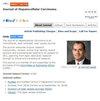Triglyceride-Glucose Index is an Independent Risk Factor for Hepatocellular Carcinoma Development in Patients with HBV-Related Liver Cirrhosis
IF 4.2
3区 医学
Q2 ONCOLOGY
引用次数: 0
Abstract
Aim: This study aimed to explore the effects of the triglyceride-glucose (TyG) index on hepatocellular carcinoma (HCC) development in patients with hepatitis B virus (HBV)-related liver cirrhosis (LC).Methods: A total of 242 patients with HBV-related LC were enrolled and followed-up. Logistic regression analysis was performed to investigate risk factors for HCC.
Results: The median follow-up time was 37 months (range: 6– 123 months). At the end of the follow-up, 11 (11.3%) patients with compensated cirrhosis (CC) and 45 (31.0%) with decompensated cirrhosis (DC) developed HCC. The TyG index was higher in the HCC group than in the non-HCC group (P=0.05). Univariate analysis showed that age (P< 0.01), DC (P< 0.01), TyG index (P=0.08), albumin (ALB) level (P=0.05), platelet (PLT) count (P< 0.01), and HBV DNA positivity (P< 0.01) were associated with HCC development. Multivariate analysis revealed that age, DC, TyG index, PLT count, and HBV DNA positivity were independent risk factors for HCC development (P=0.01, 0.01, < 0.01, 0.05, and < 0.01, respectively). For patients with DC, multivariate logistic regression analysis revealed that age, TyG index, and HBV DNA positivity were independent risk factors for HCC development (all P< 0.05). A new model encompassing age, DC, TyG, PLT, and positive HBV DNA had optimal predictive accuracy in patients with DC or CC, with a cutoff value of 0.197. The areas under the receiver operating characteristic curves (AUROCs) of the model for predicting HCC development in patients with LC, DC, and CC were 0.778, 0.721, and 0.783, respectively.
Conclusion: TyG index was identified as an independent risk factor for HCC development in patients with LC.
Keywords: hepatocellular carcinoma, triglyceride-glucose index, insulin resistance, liver cirrhosis, decompensated cirrhosis
甘油三酯-葡萄糖指数是 HBV 相关性肝硬化患者发生肝细胞癌的独立风险因素
目的:本研究旨在探讨甘油三酯-葡萄糖(TyG)指数对乙型肝炎病毒(HBV)相关肝硬化(LC)患者肝细胞癌(HCC)发展的影响:方法:共登记并随访了242例HBV相关肝硬化患者。结果:中位随访时间为 37 个月:中位随访时间为 37 个月(6-123 个月)。随访结束时,11 例(11.3%)代偿期肝硬化(CC)患者和 45 例(31.0%)失代偿期肝硬化(DC)患者发展为 HCC。HCC 组的 TyG 指数高于非 HCC 组(P=0.05)。单变量分析显示,年龄(P< 0.01)、DC(P< 0.01)、TyG 指数(P=0.08)、白蛋白(ALB)水平(P=0.05)、血小板(PLT)计数(P< 0.01)和 HBV DNA 阳性(P< 0.01)与 HCC 的发生有关。多变量分析表明,年龄、DC、TyG 指数、PLT 计数和 HBV DNA 阳性是 HCC 发生的独立危险因素(分别为 P=0.01、0.01、< 0.01、0.05 和 < 0.01)。对于 DC 患者,多变量逻辑回归分析显示,年龄、TyG 指数和 HBV DNA 阳性是 HCC 发生的独立危险因素(均为 P<0.05)。一个包含年龄、DC、TyG、PLT 和 HBV DNA 阳性的新模型对 DC 或 CC 患者具有最佳预测准确性,临界值为 0.197。该模型预测LC、DC和CC患者发生HCC的接收者操作特征曲线下面积(AUROCs)分别为0.778、0.721和0.783:关键词:肝细胞癌;甘油三酯-葡萄糖指数;胰岛素抵抗;肝硬化;失代偿期肝硬化
本文章由计算机程序翻译,如有差异,请以英文原文为准。
求助全文
约1分钟内获得全文
求助全文

 求助内容:
求助内容: 应助结果提醒方式:
应助结果提醒方式:


